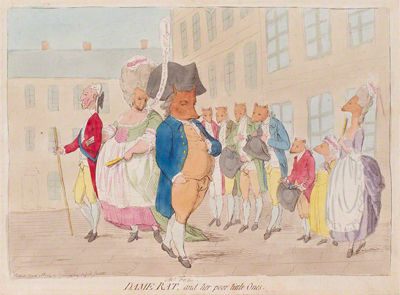Dame Rat, and Her Poor Little Ones
Although it is entitled Dame Rat, and Her Poor Little Ones, the central figure of this print is Charles James Fox (Mr. Reynard), who had become Foreign Secretary earlier in the month at the same time that Francis Seymour Conway, the Earl of Hertford (in formal red), was losing his longtime position as Lord Chamberlain. If, as the British Museum commentary on this print notes, the buildings in the background are a "a free rendering of one of the courts of St. James's Palace," the initial suggestion is of two politicians moving in opposite directions: one gaining and the other losing power and influence.

©National Portrait Gallery, London
The immediate impetus for the print, however, is supposed to have come from a report in the Morning Herald a week earlier detailing a conversation between Fox and George Selwyn. Lady Hertford had sent Fox an invitation on behalf of her husband to a ball at their house, no doubt to curry favor with the young and rising star. Hence the text bubble from Dame Rat in the print where she says " Happy to see you on Monday Mr. Reynard." When asked about the contents of the message, however, Fox is said to have replied with a disdain that is well captured by Gillray: " A petition from a poor woman with thirteen children." And we know, in fact, that "although invited in so distinguishing a manner," Fox declined to attend.
Earl Hertford was the brother of the much more politically active General Henry Seymour-Conway and a cousin of Horace Walpole, and he had indeed thirteen children: seven sons and six daughters. With so many mouths to feed, it is not surprising that the Earl was best known for his single-minded attention to his own and his family's aggrandizement. According to A. Audrey Locke, in The Seymour Family: History and Romance,
he was cautious, reserved, selfish and mean, a place-seeker, trimming his political opinions to meet the views of the party in power.
Indeed that may explain why Lady Hertford and her children all appear as rats. For while Lord Hertford is still maintaining the staff and uniform of Lord Chamberlain in the North ministry (we are told that he was "very reluctant to resign his office, and is said not to have surrendered his gold key until after the appointment of the Duke of Manchester on 10 April 1782") his wife and children have already abandoned the ship of state and are active petitioners of Fox and the new ministry.
This view is perhaps further reinforced by the next Gillray print to feature the Earl and his family, The Jubilee [August 1782]. There Lord and Lady Hertford and family are no longer bowing and scraping to Fox, but dancing around the gibbet where he hangs.
Like other Gillray prints, there are no heroes here. Reynard the Fox was a trickster, known in a series of traditional stories for being wily and untrustworthy. Associating Fox with Reynard was certainly no compliment. And the rat-like Seymours and the stony-faced Lord Hertford are equally unsympathetic.
Sources and Reading
- Commentary from the British Museum on Dame Rat, and Her Poor Little Ones
- "Two Brothers: The First Marquess of Hertford" The Seymour Family: History and Romance
Comments & Corrections
NOTE: Comments and/or corrections are always appreciated. To make that easier, I have included a form below that you can use. I promise never to share any of the info provided without your express permission.